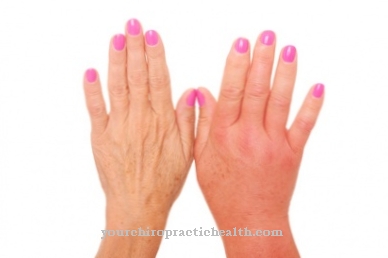Yellow eyes in most cases indicate disorders in the liver or bile. If yellowish discoloration of the skin and mucous membranes also occurs, this is called jaundice (jaundice). The symptom can hide both harmless causes, such as an impaired breakdown of metabolic products, but also serious blood and liver diseases. In any case, yellow eyes must therefore be examined by a doctor immediately.
What are yellow eyes

One speaks of "" yellow eyes "when the dermis (sclera) of the eye shows a significant yellowish deviation from its normal white color. The yellowish discoloration in the edge areas of the eyeball, which are covered by the lids, is often more noticeable.
Yellow eyes are not a disease in their own right, but an indicator of underlying diseases. If the yellowing is caused by liver or bile disorders, it is usually accompanied by a general yellowish discoloration of the skin and often also by painful abdominal discomfort.
Jaundice can also occur as part of blood diseases or intolerance to blood transfusions. Yellowing of the eyes can also be a symptom of the harmless, inherited metabolic disorder Morbus Meulengracht (alias Gilbert syndrome). In all cases, yellow eyes are due to an excessive concentration of the bile pigment bilirubin in the blood, which in turn can be caused by a variety of causes.
causes
Yellow eyes are most common in jaundice. The bile pigment responsible for this is created as a breakdown product when the red blood pigment hemoglobin decomposes.
The initially insoluble "indirect bilirubin" is normally metabolized in the liver to a water-soluble degradation product ("direct bilirubin"), reaches the intestine via the bile and is excreted. Increased bilirubin levels are often caused by disorders of this conversion process or the outflow of bile, e.g. B. by gallstones.
The cause can also lie outside of the hepatobiliary tract. This case is e.g. B. occurs when excessive red blood cells spontaneously break down. Reasons for this are hereditary or acquired blood diseases, immune diseases, infections (e.g. malaria), intolerance to blood transfusions, etc. Too much indirect bilirubin is produced, which the liver is unable to cope with.
If, on the other hand, the problem is a malfunction of the liver, inflammation of the liver (hepatitis) may be present. Excessive consumption of liver-damaging substances (alcohol, poisons and certain drugs) also leads to a weakening of the organ. In rare cases, yellow eyes appear temporarily after operations, during pregnancy and in newborns.
You can find your medication here
➔ Medicines for jaundice and liver problemsDiseases with this symptom
- Gallstones
- Gallbladder inflammation
- Gallbladder cancer and bile duct cancer
- Cholangitis (inflammation of the bile duct)
- hepatitis
- Cirrhosis of the liver
- Cholestasis
- Liver failure
- Inflammation of the pancreas (pancreatitis)
- Yellow fever
- Gilbert-Meulengracht's disease
- Right heart failure
Diagnosis & course
Yellow eyes are a noticeable symptom that usually causes those affected to see a doctor early. To find the cause of the yellowing, the patient's blood is first examined. The blood values provide information about potentially disturbed organ functions and abnormalities in the blood debris.
In addition, an extensive anamnesis takes place to record the medical history and any additional complaints - such as pain and digestive problems. Palpation of the organs in the abdomen can draw attention to pressure-sensitive areas in the liver and bile.
Ultrasound examinations as well as urine and stool samples, particularly with a view to the color of the excretions, also indicate possible causes of impaired bilirubin breakdown. In general, the prognosis of the course of jaundice depends heavily on the cause and the time at which treatment begins, especially if the yellow eyes are the result of a progressive liver degenerative disease.
Complications
By naming the complication, a disorder should be discussed. The expression of the complication declares a consequence of a health disorder or the side effect of a medical preparation that is used against this disease. Complications can thus arise from a misdiagnosis and in the course of the medical procedure. Yellow eyes are a possible complication of liver or gallbladder disease, which are classified as diseases of the digestive system. Yellow eyes can also bring further complications.
Yellow eyes are caused by congestion of the bile or an incorrect position of the bile duct, which are caused, for example, by gallstones. Complications usually arise in debilitated patients. In order to avoid dangerous complications, a medical examination must be carried out after the first symptoms have appeared. Sometimes the sufferer should be treated in a clinic in the course of eliminating existing complications, such as yellow eyes. A concept for the following outpatient procedure against yellow eyes or the actual disorder can be determined there.
Yellow eyes are a complication of liver and gallbladder diseases, not a separate clinical picture. A healthy lifestyle, avoiding alcohol and sugar confectionery as well as regular preventive care can avoid yellow eyes and hepatobiliary diseases. A low-fat diet is sometimes indicated. Numerous medical preparations are harmful to the bile and therefore not to be used in hepatobiliary diseases.
When should you go to the doctor?
Yellow eyes are not an independent clinical picture, but always a symptom. The yellowing of the white part of the eyeballs often indicates impaired functions of the liver or bile. They are often associated with other features of jaundice such as yellowing of the skin and mucous membranes and of the stool. For this reason alone, yellow eyes are a reason to seek medical treatment immediately. This is by no means just a cosmetic problem.
In addition to the liver-gallbladder disorder, which is often the cause of yellowing of the eyes, there are other reasons for this: For example, yellow eyes can also be due to increased blood lipid levels that also require treatment, as well as various infections or diseases of the blood. In addition, some medicines can cause yellow eyes.
An immediate visit to the doctor due to the "yellow eyes" indicator saves valuable time and in extreme cases can even save lives. At least a disease discovered as early as possible is easier to treat and means less suffering for the patient. Especially with liver diseases, pain often only occurs at an advanced stage Yellow eyes can certainly be seen as an early warning system. Conversely, however, eyes not colored yellow do not mean that everything is in order in terms of health. Only the doctor can assess that.
Doctors & therapists in your area
Treatment & Therapy
The treatment of yellow eyes depends on the diagnosed cause. The treatment options then depend on whether the cause is pre-hepatic (Latin pre = before; hepa = liver), hepatic or post-hepatic (Latin post = after) nature. Treatment success varies depending on the severity of the disease.
If the hereditary Gilbert syndrome is present, treatment is usually neither possible nor necessary. The breakdown of bilirubin is slightly disturbed here, but there is no serious disturbance with a disease value. Nevertheless, it is advisable for those affected to limit their consumption of alcohol and medication.
In the case of prehepatic causes, various negotiation options are available to normalize the hemoglobin content by administering or taking certain blood components. However, intolerance to blood transfusions must be accepted in life-threatening cases.
If there is acute or chronic hepatitis, antiviral drugs can be used in the case of infectious diseases, which contain the inflammation. If the liver tissue is severely damaged, a liver transplant may be necessary.
With posthepatic causes, i.e. Disturbances of the bile outflow, gallstones or narrowing of the bile ducts are usually removed or treated by minimally invasive surgical interventions.
Outlook & forecast
Yellow eyes are not an expression of a specific eye disease, but they usually signal a disease of the liver or gall bladder. The prospect and prognosis of yellow eyes therefore depend on the development and prognosis of the underlying primary disease. Conversely, this also means that once the primary disease has healed, the yellowing of the eyes will automatically be reduced because it is a reversible symptom.
If the yellowing of the eyes goes along with yellowing of the skin, the most likely cause is hepatitis, cirrhosis of the liver or obstruction of the bile ducts. In all cases there is an increased concentration of the bile pigment bilirubin, which is produced as an intermediate product from the breakdown of the blood pigment hemoglobin. The prospect and prognosis of jaundice are therefore directly dependent on the course of the underlying disease that causes it.
If the bile ducts are blocked by gallstones, the bile fluid, including bilirubin, can build up, which can cause jaundice to rise in the bilirubin concentration in the blood. In this case, the outlook and prognosis are positive, provided that the congestion in the bile ducts can be removed and the increased concentration of bilirubin is reduced again.
If the use of medication is the triggering factor for the yellowing of the eyes, stopping the medication is sufficient for a positive prognosis.
You can find your medication here
➔ Medicines for jaundice and liver problemsprevention
The best way to prevent yellow eyes is through a lifestyle that is gentle on the liver and gall bladder. These include, in particular, moderate alcohol and drug consumption.
The bile can be relieved by a reduced-fat diet. If you have to travel to exotic countries, you must have adequate vaccination against hepatitis A and B and malaria prophylaxis must be considered.
Also, attention should always be paid to food hygiene, as the ingestion of toxic decomposition products and certain molds damage the liver and can thus be partly responsible for the appearance of yellow eyes.
You can do that yourself
If the inside of the eye is discolored yellow, this indicates a liver dysfunction. The yellow color is due to an increased bilirubin level, as metabolic products are no longer sufficiently broken down. There are numerous reasons for this, most of which are worth treating. The most common causes are diseases of the liver and gall bladder, for example chronic or acute liver inflammation or gallstones.
Self-help is of little use, because the cause must be treated. If the yellowing is accompanied by pain in the abdominal area, a visit to the doctor is strongly recommended. Acute jaundice must be treated with medication. If the yellow color of the eyeball was caused by excessive alcohol consumption, the patient must be abstinent immediately. If there is an addiction behind it, this should be treated in an appropriate facility. Sometimes the yellowing of the eyes is due to a diet that is very high in fat. Here too, the waste products of the metabolism are deposited in the mucous membranes. A change in diet to low-fat, vitamin-rich foods is advisable. In the first few days, light foods should determine the nutrition plan.
If the discoloration of the eyeball was caused by minor injuries to the blood vessels, there is no need to worry. However, if your vision is impaired and your eyes are sore, you should see an ophthalmologist. In all other cases, cooling and protecting the eyes help. If the blood can flow away again unhindered, the yellow coloration also goes back.




.jpg)



















.jpg)



